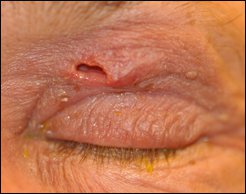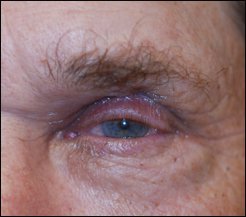Patient presents with chronic unilateral periorbital edema
A 57-year-old white male was referred on the same day for an urgent consult from his optometrist. He was concerned about an area of swelling on his left upper eyelid. He described a mildly painful, swollen nodule above his left eye that had begun 7 months ago with no provocation.
The patient’s ocular history was unremarkable for any ocular diseases, surgeries, trauma or spectacle correction. He was a current, every-day smoker with no cessation intention. His systemic medical history included migraine headaches without aura for which he was taking oral sumatriptan 100 mg once a day and oral nortriptyline 50 mg once at bedtime. He also had chronic back pain and bursitis of the shoulder for which he was taking oral gabapentin 300 mg once at bedtime and oral orphenadrine 100 mg twice a day as needed. He had no known drug allergies.
The patient had initially presented to the emergency department 7 months prior when his left upper eyelid swelling began. He reported it as an acute onset with no associated trauma or allergic reaction. He denied any other associated signs and symptoms of pain, warmth, redness, drainage, mattering or decrease in vision. He also denied any illness, fever, headache or nasal congestion. He was diagnosed with meibomian gland obstruction of the left upper eyelid and was told to use warm compresses twice a day.
A week later, he visited his optometrist, who diagnosed preseptal cellulitis of the left upper eyelid secondary to chalazion. In addition to hot compresses, she prescribed cephalexin 500 mg to be taken twice daily for 10 days. He was told to return to the clinic if no resolution was seen after completing the cephalexin course.
Five months later, the patient returned to his optometrist with concerns of chronic and worsening eyelid edema of the left upper eyelid. He had noted slight resolution of the edema after taking cephalexin months prior, but it had worsened again. Pain and tenderness was starting to develop and become more constant. He reported using hot compresses with no improvement.

CT scan showing complete opacification of left maxillary, ethmoid and frontal sinuses.

Firm nodule above the left eyelid and secondary ptosis at initial presentation.
Images: Bavasi A
He was diagnosed with allergic lid edema and conjunctivitis at this visit and was prescribed olopatadine HCl ophthalmic solution 0.1% twice a day in each eye and daily cold compresses. An oral methylprednisolone 1-week dose pack was also prescribed.
The patient returned to his optometrist’s office a few weeks later with increased pain and swelling in his left upper eyelid. He had been using the prescribed olopatadine twice a day in each eye and cold compresses daily with no improvement. He described sharp pain in the prominent bump below his left eyebrow. The pain radiated to his head. He was found to have restricted extraocular motility and diplopia. At this time he was referred to our clinic.
Uncorrected visual acuity was 20/30 with no improvement on pinhole in the right eye and 20/40 in the left eye with improvement to 20/20-2 on pinhole. Pupils were equal, round and reactive to light, with no relative afferent pupillary defect. Extraocular motility testing revealed restricted up-gaze accompanied by pain and diplopia when looking superiorly and to the left. Sensorimotor cover testing revealed a 2 prism diopter esotropia in superior gaze and a 2 prism diopter left hypotropia and 2 prism diopter esotropia in left gaze. Exophthalmometry with a base of 103 mm measured 16 mm for each eye. There was no resistance upon retropulsion of either globe.
Examination revealed an erythematous, edematous and nodular lesion overlying the tarsal crease of the left upper eyelid, located centrally below the left eyebrow and measuring approximately 1.5 cm x 1.0 cm. The patient experienced pain with palpation over the firm and immobile lesion. The left lower eyelid and periorbital tissue was also edematous. No discharge or mattering of the lashes was present.
The corneas were clear bilaterally, the irides were flat, and each lens showed signs of trace nuclear sclerosis. Intraocular pressures measured with the iCare tonometer were 11 mm Hg in the right eye and 9 mm Hg in the left eye. A fundus examination was not performed at this visit.
The patient was diagnosed with diplopia secondary to a left orbital lesion of unknown etiology. A computed tomography (CT) scan of the orbit with and without contrast was ordered the same day.
The differential diagnoses included preseptal cellulitis, dermoid cyst, lymphoid tumor, localized neurofibroma, mucocele or subperiosteal abscess.
The patient returned 3 days later to review the CT results. Visual acuity, pupil testing, extraocular motilities, intraocular pressures and slit lamp examination were unchanged since his last visit. Repeated sensorimotor cover testing revealed about 10 prism diopters of esotropia in left gaze with a slight vertical component. Alignment in superior gaze was not able to be assessed properly, because the left eyelid lesion caused a relative ptosis, blocking the pupil. Frontal and maxillary sinus transillumination revealed opacification of the left side, while the right side transilluminated normally. The frontal and maxillary sinuses were percussed, and the patient reported no pain or asymmetry, but firm palpation produced faint pain over the left frontal sinus.
CT results showed complete obstruction of the left ostiomeatal complex with inflammatory disease extending into the preseptal left orbit and left malar soft tissue. The left maxillary sinus, anterior left ethmoid air cells and left frontal sinus showed complete opacification. The left frontal sinus exhibited periosteal thickening, indicating chronic osteitis. This chronic inflammation caused the lateral aspect of the frontal sinus floor to erode, resulting in extension of the mucosal disease into the superior aspect of the preseptal area. Another area of focal dehiscence of the anterior wall of the left maxillary sinus caused slight extension of the disease into the deep malar subcutaneous soft tissue. The scan also showed focal thinning of both the floor and roof of the infraorbital canal. There was no obvious orbital or intracranial extension of the sinus disease.

Alexandra Bavasi
The patient was diagnosed with left-sided pansinusitis. He was referred to otorhinolaryngology for further assessment and treatment. He reported to the otorhinolaryngologist the day before his appointment; the associated pain in his left upper eyelid reached a high intensity and subsequently developed a fistula that began to drain a thick purulent fluid. He was started on amoxicillin clavulanate 875 mg/125 mg every 12 hours and was scheduled for surgery the following day.
Surgical procedure
The surgical procedure included right endoscopic concha bullosa resection, endoscopic septoplasty, left endoscopic maxillary antrostomy with tissue removal, left anterior ethmoidectomy, left frontal sinustomy, left frontal sinus trephination and left upper eyelid fistula excision and closure. There were no apparent complications, and the patient tolerated the procedure well. He was discharged the same day. He was prescribed oxycodone 10 mg every 12 hours and over-the-counter ibuprofen 200 mg every 6 hours for pain management and was instructed to continue his amoxicillin clavulanate regimen for another 10 to 14 days.
The patient returned 2 weeks later for a follow-up appointment with the otorhinolaryngologist. He reported some difficulty breathing through his nose. Facial exam showed no swelling. The surgically placed intranasal splints were removed. After the nose was anesthetized, nasal endoscopy with débridement was performed on both sides. The middle turbinate remained in good position on the right and left sides. The left antrostomy and ethmoidectomy were widely patent. The left frontal sinus could be visualized, which showed no crusting or blockage. He was instructed to finish his course of antibiotics and was prescribed hydrocodone-acetaminophen 2.5 mg/325 mg every 6 hours for pain management. He was cleared to return to work the following week.
Epidemiology
Sinusitis affects 35 million Americans (Meltzer et al.), but this number is misleading, because it is often undiagnosed due to occasional subtle clinical presentation. The primary cause of sinusitis usually involves a blockage somewhere along the ostiomeatal complex and nasal passages. Decreased air flow leads to proliferation of microorganisms, impairment of local defenses and mucous membrane swelling and drainage. Predisposing factors include upper respiratory tract infections, dental infections, allergic rhinitis, anatomic ostial compromise, environmental pollution, smoking and nasal polyposis. Patients who develop sinusitis usually suffer symptoms of congestion, colored nasal discharge, postnasal drip, facial pressure, headache, cough, lack of smell and ear fullness, but some patients can remain relatively asymptomatic.

Presurgical appearance of the left upper eyelid fistula after drainage and débridement.

Appearance 2 weeks postoperatively.
The time course of the disease can be acute (up to 4 weeks), subacute (4 to 12 weeks), recurrent (four or more episodes per year) or chronic (12 weeks or more). If left untreated, serious bouts of sinusitis can cause secondary complications, including orbital cellulitis, orbital abscess, meningitis, cavernous sinus thrombosis and intracranial abscess, any of which could result in severe morbidity or mortality.
Examination
A thorough case history can help the optometrist diagnose acute or chronic sinusitis. An evaluation of visual acuities, pupils, extraocular motilities, anterior segment, exophthalmometry and core temperature can help to identify any secondary periorbital, orbital or ocular complications. Optometrists can also easily palpate, percuss and transilluminate the frontal and maxillary sinuses. The ethmoid and sphenoid sinuses are not accessible to these diagnostic techniques.
CT scans should be ordered to evaluate periosteal or mucosal thickening, abscess formation, orbital involvement and sinus opacification. This turned out to be an important step in the evaluation of our patient. Other potentially helpful examination and testing procedures include otoscopy, anterior rhinoscopy, nasal cytology, sinus aspiration, rhinopharyngoscopy and magnetic resonance imaging.
Treatment
Depending on the severity and extent of sinus involvement, many different treatment approaches can be utilized. In simple cases, steam and saline can be used to help open the ostiomeatal complex. Analgesics such as nonsteroidal anti-inflammatory drugs or acetaminophen can help reduce pain. Topical and oral decongestants and mucoevacuants can reduce edema and promote drainage. Antihistamines are not generally recommended, as they can cause over-drying of the mucosal tissue.
Antibiotics, including amoxicillin with or without clavulanate, trimethoprim-sulfamethoxazole, levofloxacin and others, can help manage the bacterial infection. Topical nasal steroids such as beclomethasone, triamcinolone and mometasone can help suppress inflammation and symptoms of rhinosinusitis. Oral steroids such as prednisone should only be used in chronic cases of sinusitis. If recalcitrant cases of sinusitis or pansinusitis develop, functional endoscopic sinus surgery, which was included in the care of our patient, is indicated to open, drain and flush the diseased sinuses.
Acute and chronicperiorbital sinusitis is a common health condition that can have serious secondary ocular manifestations. Although most patients may experience obvious symptoms, others may remain relatively asymptomatic. It is important for optometrists to perform all appropriate testing and to promptly send for imaging if indicated. An appropriate and timely referral to an otorhinolaryngologist for further assessment and treatment is imperative, especially in chronic or recurrent cases.
